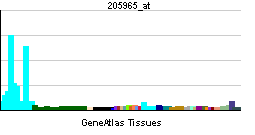BATF (gene)
| Basic leucine zipper transcription factor, ATF-like | |||||||||||
|---|---|---|---|---|---|---|---|---|---|---|---|
| Identifiers | |||||||||||
| Symbols | BATF ; B-ATF; BATF1; SFA-2 | ||||||||||
| External IDs | Template:MGI HomoloGene: 4666 | ||||||||||
| |||||||||||
| RNA expression pattern | |||||||||||
 | |||||||||||
| More reference expression data | |||||||||||
| Orthologs | |||||||||||
| Template:GNF Ortholog box | |||||||||||
| Species | Human | Mouse | |||||||||
| Entrez | n/a | n/a | |||||||||
| Ensembl | n/a | n/a | |||||||||
| UniProt | n/a | n/a | |||||||||
| RefSeq (mRNA) | n/a | n/a | |||||||||
| RefSeq (protein) | n/a | n/a | |||||||||
| Location (UCSC) | n/a | n/a | |||||||||
| PubMed search | n/a | n/a | |||||||||
Basic leucine zipper transcription factor, ATF-like, also known as BATF, is a human gene.[1]
The protein encoded by this gene is a nuclear basic leucine zipper protein that belongs to the AP-1/ATF superfamily of transcription factors. The leucine zipper of this protein mediates dimerization with members of the Jun family of proteins. This protein is thought to be a negative regulator of AP-1/ATF transcriptional events.[1]
References
Further reading
- Rual JF, Venkatesan K, Hao T; et al. (2005). "Towards a proteome-scale map of the human protein-protein interaction network". Nature. 437 (7062): 1173–8. doi:10.1038/nature04209. PMID 16189514.
- Gerhard DS, Wagner L, Feingold EA; et al. (2004). "The status, quality, and expansion of the NIH full-length cDNA project: the Mammalian Gene Collection (MGC)". Genome Res. 14 (10B): 2121–7. doi:10.1101/gr.2596504. PMID 15489334.
- Deppmann CD, Thornton TM, Utama FE, Taparowsky EJ (2003). "Phosphorylation of BATF regulates DNA binding: a novel mechanism for AP-1 (activator protein-1) regulation". Biochem. J. 374 (Pt 2): 423–31. doi:10.1042/BJ20030455. PMID 12809553.
- Johansen LM, Deppmann CD, Erickson KD; et al. (2003). "EBNA2 and activated Notch induce expression of BATF". J. Virol. 77 (10): 6029–40. PMID 12719594.
- Williams KL, Zullo AJ, Kaplan MH; et al. (2003). "BATF transgenic mice reveal a role for activator protein-1 in NKT cell development". J. Immunol. 170 (5): 2417–26. PMID 12594265.
- Heilig R, Eckenberg R, Petit JL; et al. (2003). "The DNA sequence and analysis of human chromosome 14". Nature. 421 (6923): 601–7. doi:10.1038/nature01348. PMID 12508121.
- Strausberg RL, Feingold EA, Grouse LH; et al. (2003). "Generation and initial analysis of more than 15,000 full-length human and mouse cDNA sequences". Proc. Natl. Acad. Sci. U.S.A. 99 (26): 16899–903. doi:10.1073/pnas.242603899. PMID 12477932.
- Echlin DR, Tae HJ, Mitin N, Taparowsky EJ (2000). "B-ATF functions as a negative regulator of AP-1 mediated transcription and blocks cellular transformation by Ras and Fos". Oncogene. 19 (14): 1752–63. doi:10.1038/sj.onc.1203491. PMID 10777209.
- Meyer NP, Johansen LM, Tae HJ; et al. (1998). "Genomic organization of human B-ATF, a target for regulation by EBV and HTLV-1". Mamm. Genome. 9 (10): 849–52. PMID 9745044.
- Wang X, Johansen LM, Tae HJ, Taparowsky EJ (1997). "IFP 35 forms complexes with B-ATF, a member of the AP1 family of transcription factors". Biochem. Biophys. Res. Commun. 229 (1): 316–22. doi:10.1006/bbrc.1996.1799. PMID 8954125.
- Hasegawa H, Utsunomiya Y, Kishimoto K; et al. (1996). "SFA-2, a novel bZIP transcription factor induced by human T-cell leukemia virus type I, is highly expressed in mature lymphocytes". Biochem. Biophys. Res. Commun. 222 (1): 164–70. doi:10.1006/bbrc.1996.0700. PMID 8630063.
- Dorsey MJ, Tae HJ, Sollenberger KG; et al. (1996). "B-ATF: a novel human bZIP protein that associates with members of the AP-1 transcription factor family". Oncogene. 11 (11): 2255–65. PMID 8570175.
External links
- BATF+protein,+human at the US National Library of Medicine Medical Subject Headings (MeSH)
| This protein-related article is a stub. You can help Wikipedia by expanding it. |
This article incorporates text from the United States National Library of Medicine, which is in the public domain.